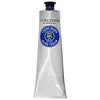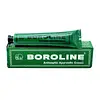What's inside
What's inside
 Key Ingredients
Key Ingredients

 Benefits
Benefits

 Concerns
Concerns

 Ingredients Side-by-side
Ingredients Side-by-side

Water
Skin ConditioningButyrospermum Parkii Butter
Skin ConditioningGlycerin
HumectantCoco-Caprylate/Caprate
EmollientCetearyl Alcohol
EmollientGlyceryl Stearate
EmollientBrassica Campestris Sterols
EmollientArgania Spinosa Kernel Oil
EmollientCocos Nucifera Oil
MaskingHelianthus Annuus Seed Oil
EmollientPEG-100 Stearate
Hydroxyethyl Acrylate/Sodium Acryloyldimethyl Taurate Copolymer
Emulsion StabilisingCeteareth-33
CleansingCaprylyl Glycol
EmollientEthylhexylglycerin
Skin ConditioningSorbitan Isostearate
EmulsifyingPolysorbate 60
EmulsifyingPentylene Glycol
Skin ConditioningBeta-Glucan
Skin ConditioningTocopherol
AntioxidantParfum
MaskingLinalool
PerfumingCoumarin
PerfumingCitronellol
PerfumingAlpha-Isomethyl Ionone
PerfumingLimonene
PerfumingGeraniol
PerfumingWater, Butyrospermum Parkii Butter, Glycerin, Coco-Caprylate/Caprate, Cetearyl Alcohol, Glyceryl Stearate, Brassica Campestris Sterols, Argania Spinosa Kernel Oil, Cocos Nucifera Oil, Helianthus Annuus Seed Oil, PEG-100 Stearate, Hydroxyethyl Acrylate/Sodium Acryloyldimethyl Taurate Copolymer, Ceteareth-33, Caprylyl Glycol, Ethylhexylglycerin, Sorbitan Isostearate, Polysorbate 60, Pentylene Glycol, Beta-Glucan, Tocopherol, Parfum, Linalool, Coumarin, Citronellol, Alpha-Isomethyl Ionone, Limonene, Geraniol
 Reviews
Reviews

Ingredients Explained
These ingredients are found in both products.
Ingredients higher up in an ingredient list are typically present in a larger amount.
Parfum is a catch-all term for an ingredient or more that is used to give a scent to products.
Also called "fragrance", this ingredient can be a blend of hundreds of chemicals or plant oils. This means every product with "fragrance" or "parfum" in the ingredients list is a different mixture.
For instance, Habanolide is a proprietary trade name for a specific aroma chemical. When used as a fragrance ingredient in cosmetics, most aroma chemicals fall under the broad labeling category of “FRAGRANCE” or “PARFUM” according to EU and US regulations.
The term 'parfum' or 'fragrance' is not regulated in many countries. In many cases, it is up to the brand to define this term.
For instance, many brands choose to label themselves as "fragrance-free" because they are not using synthetic fragrances. However, their products may still contain ingredients such as essential oils that are considered a fragrance by INCI standards.
One example is Calendula flower extract. Calendula is an essential oil that still imparts a scent or 'fragrance'.
Depending on the blend, the ingredients in the mixture can cause allergies and sensitivities on the skin. Some ingredients that are known EU allergens include linalool and citronellol.
Parfum can also be used to mask or cover an unpleasant scent.
The bottom line is: not all fragrances/parfum/ingredients are created equally. If you are worried about fragrances, we recommend taking a closer look at an ingredient. And of course, we always recommend speaking with a professional.
Learn more about Parfum